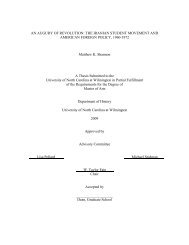Saprolegnia - The iLumina Digital Library
Saprolegnia - The iLumina Digital Library
Saprolegnia - The iLumina Digital Library
You also want an ePaper? Increase the reach of your titles
YUMPU automatically turns print PDFs into web optimized ePapers that Google loves.
<strong>Saprolegnia</strong>ceae, p. 56, pl. 17. 1923<br />
(Figure 93 F-H)<br />
Monoecious. Hyphae sparingly branched. Sporangia filiform, cylindrical,<br />
pyriform, or irregularly clavate; straight, curved, or irregular; renewed internally, or by<br />
cymose or sympodial branching, or in basipetalous succession; 40-432 x 10-63 µm.<br />
Spores dimorphic, or rarely monomorphic; discharge and behavior saprolegnoid, rarely<br />
dictyucoid or aplanoid; primary spore cysts 10-13 µm in diameter. Gemmae abundant;<br />
spherical, oval, or irregular; terminal, rarely intercalary; catenulate or single. Oogonia<br />
lateral, occasionally terminal, very rarely intercalary; occasionally glomerulate;<br />
spherical, napiform, or obpyriform, rarely () apiculate; (36-) 42-56 (-106) µm in<br />
diameter. Oogonial wall pitted or unpitted; smooth. Oogonial stalks stout; ( 1 / 4 -) 1 (-4)<br />
times the diameter of the oogonium, in length; straight, curved, or irregular;<br />
unbranched or branched. Oospores subcentric, rarely centric; 1-2 (-12) per oogonium,<br />
and usually not filling it; (14-) 32-38 (-52) µm in diameter; germination not observed.<br />
Antheridial branches, when present, monoclinous or diclinous, occasionally<br />
androgynous; slender, curved or slightly irregular, unbranched or branched; persisting.<br />
Antheridial cells simple; persisting; apically or laterally appressed; fertilization tubes<br />
usually present, not persisting.<br />
Generally, each oogonium of <strong>Saprolegnia</strong> megasperma has only one large and<br />
prominent oospore. As Coker (loc. cit.) mentioned, the oogonia of this species<br />
occasionally are arranged racemosely in clusters near the ends of hyphae. Furthermore,<br />
Seymour (1970) found the oogonia to be glomerulate at times. Both of these authors<br />
reported the monoclinous antheridial filaments to be unbranched, but in the specimen<br />
we have from Sweden, they are occasionally once-branched.<br />
Insofar as we can determine, the only difference between <strong>Saprolegnia</strong> megasperma<br />
and S. unispora is that the former has antheridia but the latter does not. <strong>The</strong><br />
arrangement of oogonia in S. unispora in a scorpioid cyme (Coker, 1923: pl. 23, figs. 2, 3)<br />
is a characteristic found also occasionally in S. megasperma.<br />
An isolate identified as S. megasperma deposited at the Centraalbureau, Baarn,<br />
lacks antheridial filaments. That specimen must therefore be identified as S. unispora.<br />
CONFIRMED RECORDS: --AUSTRALIA: Cookson (1937:241). CANADA: Nolan<br />
(1975a: fig. 1; 1975b: figs. 5-7). JAPAN: Shibuya (1959:147, fig. 2). LATVIA: Apinis<br />
(1929a:218). SOUTH AMERICA: Beneke and Rogers (1970:59). UNITED STATES:<br />
Beneke (1948b:45); R. L. Butler (1975: figs. 53-56); Coker (loc. cit.); A. W. Ziegler<br />
(1948b:18, pl. 2, figs. 1, 2; 1952: pl. 2, fig. 3). USSR: Logvinenko and Meshcheryakova<br />
(1971: fig. 4).<br />
RECORDED COLLECTIONS: -- BRITISH ISLES: Dick (1962, 1963, 1966); Dick<br />
and Newby (1961); Willoughby and Collins (1966). JAPAN: Suzuki (1961f); Suzuki and<br />
Hatakeyama (1960). SOUTH AMERICA: Upadhyay (1967). UNITED STATES: Farr and<br />
Paterson (1974); G. C. Hughes (1959, 1962); Poitras (1955); A. W. Ziegler (1958b).<br />
639
















